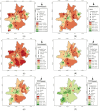Spatially Resolved Distribution, Sources, Exposure Levels, and Health Risks of Heavy Metals in <63 μm Size-Fractionated Road Dust from Lucknow City, North India
- PMID: 36232197
- PMCID: PMC9565937
- DOI: 10.3390/ijerph191912898
Spatially Resolved Distribution, Sources, Exposure Levels, and Health Risks of Heavy Metals in <63 μm Size-Fractionated Road Dust from Lucknow City, North India
Abstract
In the present study, a total of 64 road dust samples were collected from five different functional areas (residential, commercial, parks, high-traffic, and industrial) in urban Lucknow to assess the accumulation, distribution, and health risk of heavy metals (HMs) (i.e., Fe, Mn, Zn, Cu, Pb, Cd, As, Cr and Ni). Acid digestion methods were used to analyze HMs, followed by inductively coupled plasma-mass spectrometry (ICPMS). The ascending frequency of HMs was Cd < As < Ni < Cr < Pb < Cu < Zn < Mn < Fe for all different functional areas. Almost all HMs exceed the limits of Indian natural soil background values (INSB) across all functional areas. The pollution assessment results reveal that the urban road dust of Lucknow is highly enriched with Zn and Pb, causing deterioration of dust quality. The spatial distribution of HMs shows that road dust found in the central and southwestern zones of the Lucknow urban area are more contaminated than in other areas. The ecological risk assessment demonstrates that Cd was the highest risk contributor, followed by Pb, Zn and Cu. The result of the health risk assessment i.e., the cumulative hazard index (HI) and the cumulative lifetime cancer risk (LCR), reveal that children (mean HIchildren = 1.26, LCRchildren = 0.000187) are more vulnerable to HM exposure than adults (HIadults = 0.14, LCRadults = 0.0000804). For carcinogenic and non-carcinogenic risk, ingestion appears to be the major pathway of HM exposure in both age groups. It is alarming that all studied four carcinogenic HMs were found in concentrations higher than 1 × 10-6 (the permissible limit for humans). This indicates slight chances of developing cancer for both age groups in all functional areas.
Keywords: health risk assessment; heavy metals; pollution assessment; potential ecological risk; road dust; spatial distribution.
Conflict of interest statement
The authors declare that they have no known competing financial or non-financial interest to disclose.
Figures






References
-
- Rajaram B.S., Suryawanshi P.V., Bhanarkar A.D., Rao C.V.C. Heavy metal contamination in road dust in Delhi city, India. Environ. Earth Sci. 2014;72:3929–3938. doi: 10.1007/s12665-014-3281-y. - DOI
-
- Zhao N., Lu X., Chao S., Xu X. Multivariate statistical analysis of heavy metals in less than 100 μm particles of street dust from Xining, China. Environ. Earth Sci. 2015;73:2319–2327. doi: 10.1007/s12665-014-3578-x. - DOI
-
- Gupta V., Bisht L., Deep A., Gautam S. Spatial distribution, pollution levels, and risk assessment of potentially toxic metals in road dust from major tourist city, Dehradun, Uttarakhand, India. Stochastic Environ. Res. Risk Assess. :2022. doi: 10.1007/s00477-022-02207-0. in press . - DOI
MeSH terms
Substances
LinkOut - more resources
Full Text Sources
Medical
Research Materials

